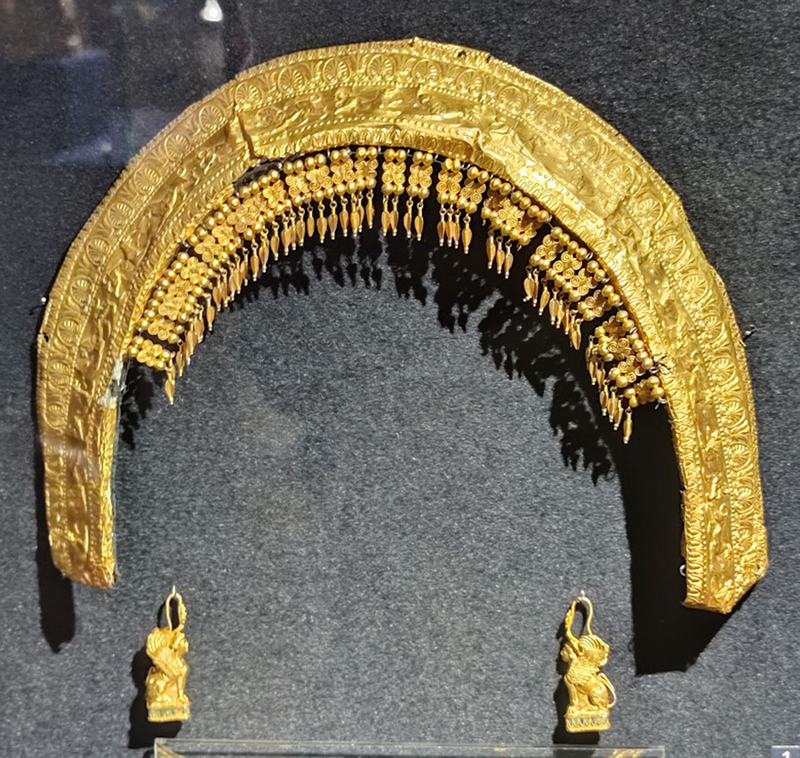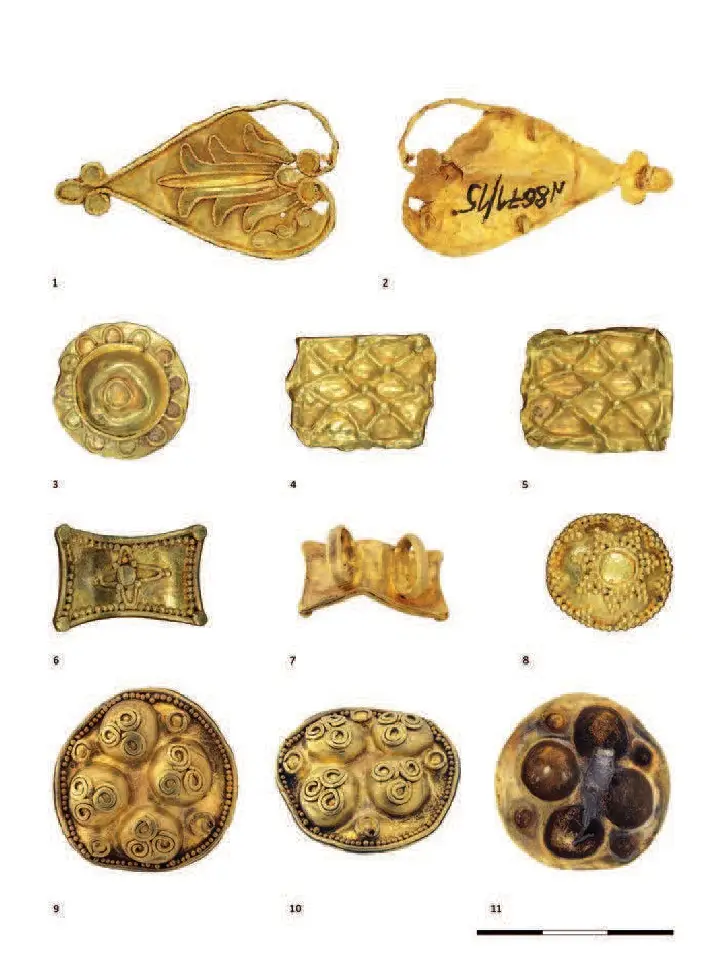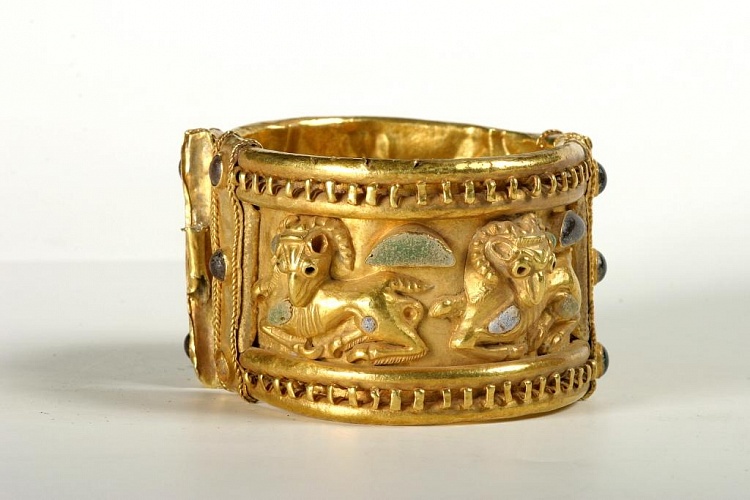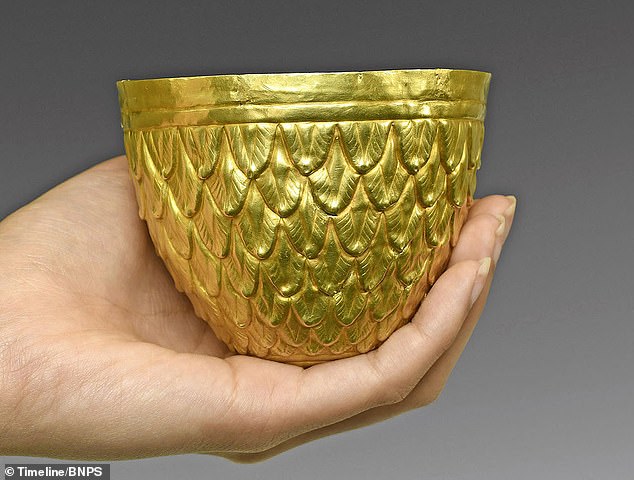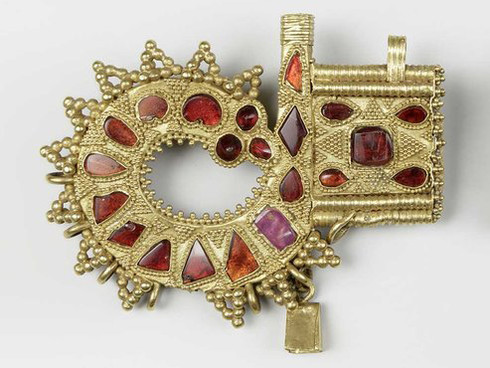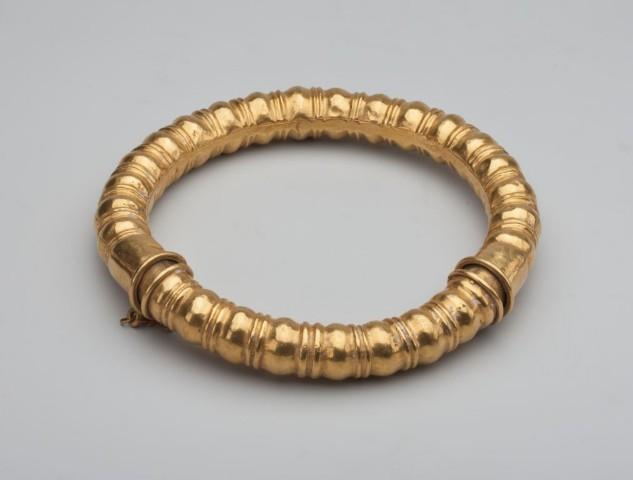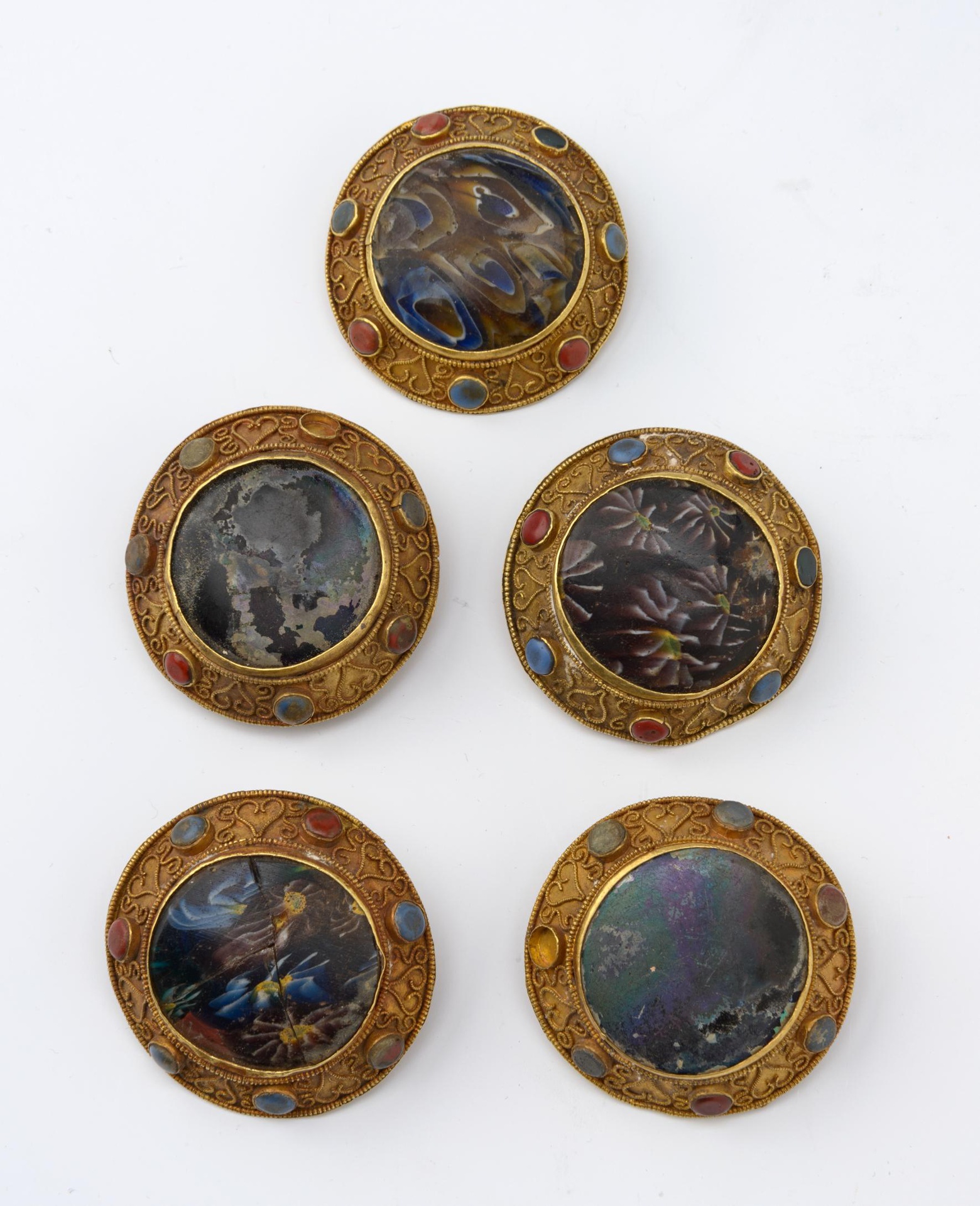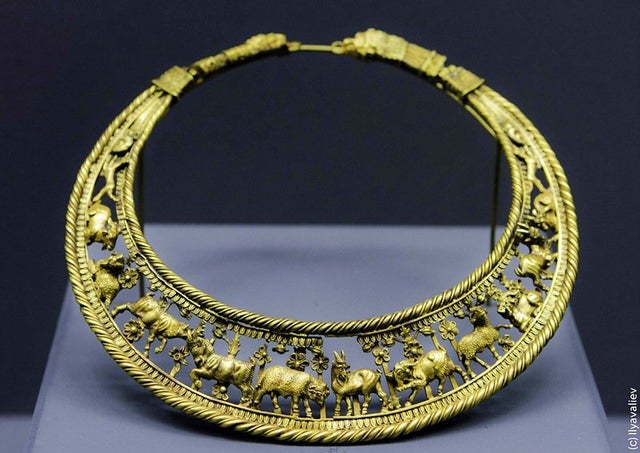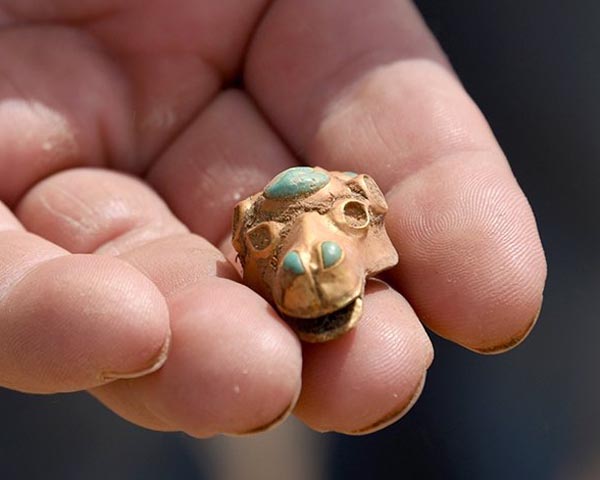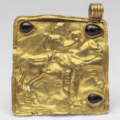SARMATIAN

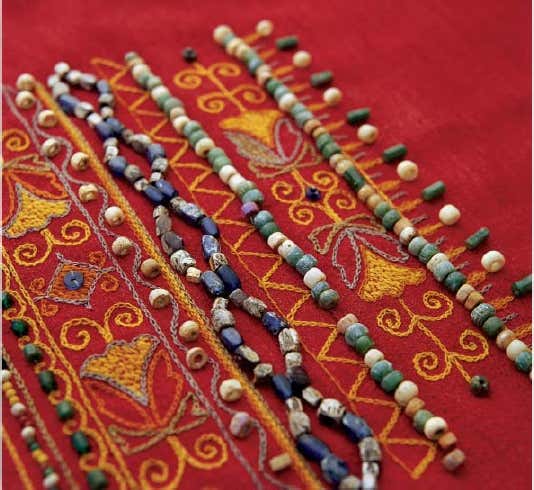
The embroidery decorating the Sarmatian female dress. [reconstruction] (Courtesy of the Hungarian National Museum; Photo: Csaba Barbay) [„On the Borders of East and West”]
SCYTHIAN

Flower-shaped textile decoration from Velykyi Ryzhanivks’kyi Kurhan, Cherkasy region,
4th–early 3rd century BCE (Courtesy of Sergei
Skoryi). [after M. Gleba, Ukraine]


[M. Gleba, You are what you wear]

[M. Gleba, You are what you wear]
The marble statue of the “Persian horseman” from Acropolis owes its name to the rider’s colorful, eastern-style attire, namely a short chiton and close-fitting trousers. The horse’s mane had green braids on a red background and its tail was also green.



“His short tunic reaches just to the beginning of the hip and is decorated with coloured palmettes and lozenges;
under it he is wearing close-fitting breeches, also decorated with lozenges, alternately red, white and dark blue or green. His feet are shod with closed shoes that are now red and were laced, as shown by the three bronze studs (…)
This horseman was an archer, as attested by part of a quiver, which is decorated with the same lozenge pattern that is on his breeches, and rested on his left side. Tradition reports that Scythian horsemen-archers had been called in to help the cavalry in the Classical period. Is this a Scythian horseman-archer or merely a Scythian groom, or perhaps a Persian who dedicated the statue on the Acropolis?” (Acropolis Museum catalog).
According to Vinzenz Brinkmann however the recent studies of the quiver’s surface and differences in the structure of the stone surface prove that the quiver belonged to a different sculpture.
Made of marble “Persian horseman” pre-dates the Persian invasion of Athens in 470 BCE, was made circa 520-510 BCE.
Used nine different pigments partly mixed with each other: azurite, malachite, and iron-oxide red.

(Saddle?) rug fragments from the Yanghai Tombs nr 1, Xinjiang, northwest China dated to early Scythian era.
8, 87, 90, 95 are thought to be the saddle rugs.
Graves 8, 87, 90, 91, 95 and 138 are attributed to stage 2 (X-VIII centuries BCE), and graves 164 and 189 – to stage 3 (VII-IV centuries BCE).
“Семь проанализированных из девяти найденных ворсовых фрагментов из могильника Янхай I выполнены с использованием иного, симметричного, узла, причем эта технология названа характерной для всех ранних ковров в Синьцзяне. Большинство находок имеют геометрический орнамент из ромбов, треугольников, возможно квадратов (Рис. 1). Фрагменты из могил 8, 87, 90, 95 названы седельными ковриками (Report 2019: vol. II, p. 921–922,fig. 19).
Погребения могильника Янхай, по мнению авторов публикации, разделяются на четы-ре этапа, а кладбище Янхай I включает захоронения, производившиеся на 1–3 этапах. Содержащие ворсовые изделия могилы 8, 87, 90, 91, 95 и 138 отнесены к этапу 2 (X–VIII вв. до н. э.), а могилы 164 и 189 — к этапу 3 (VII–IV вв. до н. э.) (Report 2019: vol. II, p. 606–617; 977–979). Неоднократно отмечалось, что предложенная китайскими исследователями хронология могильника Янхай 1 нуждается в корректировке. Еще в 2010 г. П. И. Шульга отметил необоснованность ранней датировки захоронений 1 и 2 этапов и пришел к заключению, что большая часть могил Янхая 1 относится к раннескифскому времени (Шульга 2010: 56–57)”
ВОРСОВЫЕ ИЗДЕЛИЯ ИЗ ПАМЯТНИКОВ БАССЕЙНА ТАРИМАI ТЫС. ДО Н. Э.: ОБЗОР НАХОДОК; С. В. Панкова
Государственный Эрмитаж, Санкт-Петербург, Россия
[PILE OBJECTS FROM THE TARIM BASIN Sites OF THE 1ST MILLENNIUM BC: AN OVERVIEW OF FINDS; Svetlana V. Pankova, State Hermitage, St. Petersburg, Russia]
DOI: 10.31600/978-5-907298-09-5-199-204
Древние и средневековые культуры Центральной Азии / Отв. ред. В. П. Никоноров, Л. Б. Кирчо, Е. О. Стоянов. СПб., 2020 [V. P. Nikonorov, L. B. Kircho, E. O. Stoyanov (eds.). Ancient and medieval cultures of Central Asia. St. Petersburg, 2020]; pp. 199-204

Textile fragment, nomadic culture of the Scythian type, 8th century BCE, Arzhan-1 Barrow. Sayano-Altai, Tuva, the Village Arzhan.
In the Hermitage Museum Inv. no. 2878-156




© MAFCX [“On Textile Fragments Found at Karadong“]

Xinjiang Institute of Archaeology, Urumqi, after Debaine-Francfort and Idriss, Kériya, 80, CAT. 22 [After Ciro Lo Muzio]

XINJIANG INSTITUTE OF ARCHAEOLOGY, URUMQI, AFTER
DEBAINE-FRANCFORT AND IDRISS, KÉRIYA, 103, CAT. 35
[After Ciro Lo Muzio]

the Indian cotton resist-dyed tabbies imported
during the late 4th-5th century to Berenike
[“On Textile Fragments Found at Karadong“]

https://www.penn.museum/sites/expedition/the-silk-roads-in-history/

“This child’s tunic has a resist dyed diaper pattern of rosettes within lozenge shaped compartments, and is of an unusual cut for the time. It was found in a grave at Akhmim by the Swiss archaeologist R. Forrer and dated to the 6th-7th centuries. Hitherto, most Egyptian tunics were cut in a T-shape, but the tunic shown here is of a more ‘tailored’ cut. This reflects the development of tailoring in the 6th and 7th centuries in Egypt which is thought to have been introduced by foreign tunics, predominantly from Syria and Iran.[…]
Tunics of similar cut, however, including one in cotton, have been found at Halabiych (ancient Zenobia)”
Painted with a resist, and dyed with indigo


Photo ©Victoria & Albert Museum, London, acc. nT.220 to B-1953o. https://www.trc-leiden.nl


See also Inv. no. КЗ-5066
pic. 2) Fragments of a caftan covered with a silk fabric with a Senmurv pattern; Eastern Mediterranean (Syria?), 9th century
In the Hermitage Inv. No. КЗ-6735
SOURCES:
- Persian Horseman (Acr. 606) Acropolis Museum record
- Acropolis Museum catalog
LATSIS GROUP ATHENS 1998
© The Hellenic Ministry of Culture - Vinzenz Brinkmann, The “Persian Rider” from the Athenian Acropolis; or, a Reconstruction of the “Third Generation”, 2011 https://www.jstor.org/stable/23208556
- © Vangelis Zavos https://www.greece-is.com/acropolis-museums-top-10/
- https://www.researchgate.net/publication/333151725_Ukraine Margarita Gleba
- You Are What You Wear: Scythian Costume as Identity, Margarita Gleba https://www.academia.edu
- Elena Fialko, Yurii Boltryk; Textiles from Scythian burial complexes; Tyragetia, serie nouă, vol. VII [XXII], nr. 1, Arheologie. Istorie Antică https://www.nationalmuseum.md
- „On the Borders of East and West”: A Reconstruction of Roman Provincial and Barbarian Dress in the Hungarian National Museum; Judit Pásztókai-Szeőke https://www.academia.edu
- Sino-Iranian Textile Patterns in Trans-Himalayan Areas, MARIACHIARA GASPARINI https://www.academia.edu
- On Textile Fragments Found at Karadong, a 3rd to early 4th Century Oasis in the Taklamakan Desert (Xinjiang, China); Sophie Desrosiers, Corinne Debaine-Francfort https://digitalcommons.unl.edu/tsaconf/958
- Buddhist Painting in the South of the Tarim Basin: A Chronological Conundrum. In: Buddhism in Central Asia II. Author: Ciro Lo Muzio. Type: Chapter Pages: 97–117 DOI: https://doi.org/10.1163/9789004508446_005


